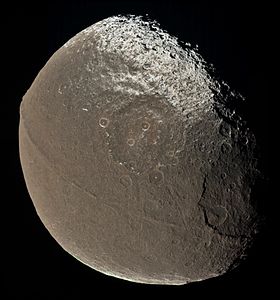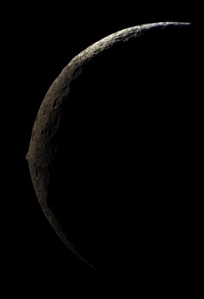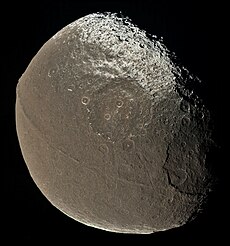 Iapetus's equatorial ridge up close as imaged by Cassini Iapetus's equatorial ridge up close as imaged by Cassini | |
| Feature type | Mountains |
|---|---|
| Location | Iapetus |
| Coordinates | 0°N 0°W / 0°N -0°E / 0; -0 |
| Length | 1,300 km (810 mi) |
| Peak | 20 km (12 mi) |
| Discoverer | Cassini |
The equatorial ridge is the tallest mountain feature on Saturn's moon Iapetus. It is 20 km (12 mi) high, and is the third tallest mountain structure in the Solar System. It runs along most of Iapetus' equator. It was discovered by the Cassini probe in 2004. The ridge's origin is unknown. There are bright areas on the sides of the equatorial ridge near Iapetus' bright trailing hemisphere, which were already visible in Voyager 2 images appearing like mountains and were nicknamed the "Voyager Mountains".
Discovery
Iapetus's equatorial ridge was discovered when the Cassini spacecraft imaged Iapetus on 31 December 2004. Peaks in the ridge rise more than 20 km above the surrounding plains, making them some of the tallest mountains in the Solar System. The ridge forms a complex system including isolated peaks, segments of more than 200 km and sections with three near parallel ridges.
Origins
Within the bright regions there is no ridge, but there are a series of isolated 10 km peaks along the equator. The ridge system is heavily cratered, indicating that it is ancient. The prominent equatorial bulge gives Iapetus a walnut-like appearance.
It is not clear how the ridge formed. One difficulty is to explain why it follows the equator almost perfectly. There are at least four current hypotheses, but none of them explains why the ridge is confined to Cassini Regio.
- A team of scientists associated with the Cassini mission have argued that the ridge could be a remnant of the oblate shape of the young Iapetus, when it was rotating more rapidly than it does today. The height of the ridge suggests a maximum rotational period of 17 hours. If Iapetus cooled fast enough to preserve the ridge but remained plastic long enough for the tides raised by Saturn to have slowed the rotation to its current tidally locked 79 days, Iapetus must have been heated by the radioactive decay of aluminium-26. This isotope appears to have been abundant in the solar nebula from which Saturn formed, but has since all decayed. The quantities of aluminium-26 needed to heat Iapetus to the required temperature give a tentative date to its formation relative to the rest of the Solar System: Iapetus must have come together earlier than expected, only two million years after the asteroids started to form.
- The ridge could be icy material that welled up from beneath the surface and then solidified. If it had formed away from the position of the equator at the time, this hypothesis requires that the rotational axis would have been driven to its current position by the ridge.
- Iapetus may have had a ring system during its formation due to its large Hill sphere, and the equatorial ridge could have then been produced by collisional accretion of this ring.
- Iapetus could have been impacted by a body that created both a ring system and a subsatellite, which would be possible due to the large Hill sphere mentioned above. The subsatellite then proceeds to quickly force the ring system down onto Iapetus, creating the ridge system, before escaping Iapetus' gravity via tidal acceleration.
- The ridge and the bulge could be the result of ancient convective overturn. This hypothesis states that the bulge is in isostatic equilibrium typical for terrestrial mountains. It means that under the bulge there is material of low density (roots). The weight of the bulge is compensated by buoyancy forces acting on the roots. The ridge is also built of less dense matter. Its position along the equator is probably a result of the Coriolis force acting on a liquid interior of Iapetus.
Gallery
-
 This series of images of Iapetus' north pole by Voyager 2 became the first-ever hints on the existence of the moon's equatorial ridge. The white and grey dots below each images (Iapetus' equator) will later be revealed to be Voyager Montes by Cassini. Taken on August 22, 1981.
This series of images of Iapetus' north pole by Voyager 2 became the first-ever hints on the existence of the moon's equatorial ridge. The white and grey dots below each images (Iapetus' equator) will later be revealed to be Voyager Montes by Cassini. Taken on August 22, 1981.
-
 A global view of Iapetus obtained by the Cassini spacecraft on Dec. 31, 2004 - the first-ever clear image of the ridge - at a distance of about 172,900 kilometers (107,435 miles). The massive structure clearly distorts the shape of the moon at the equator.
A global view of Iapetus obtained by the Cassini spacecraft on Dec. 31, 2004 - the first-ever clear image of the ridge - at a distance of about 172,900 kilometers (107,435 miles). The massive structure clearly distorts the shape of the moon at the equator.
-
 Iapetus' massive equatorial ridge is clearly visible from Cassini's images as the space probe approached Iapetus from its nightside during its closest flyby of the moon on September 10, 2007 at a distance of 83,000 kilometers (51,600 miles). The spacecraft came as close as 1,227 km (762 mi) from the moon's surface during this flyby. This is also the clearest picture of the equatorial ridge to date.
Iapetus' massive equatorial ridge is clearly visible from Cassini's images as the space probe approached Iapetus from its nightside during its closest flyby of the moon on September 10, 2007 at a distance of 83,000 kilometers (51,600 miles). The spacecraft came as close as 1,227 km (762 mi) from the moon's surface during this flyby. This is also the clearest picture of the equatorial ridge to date.
See also
References
- Iapetus' "Voyager Mountains"
- Porco, C. C.; E. Baker, J. Barbara, K. Beurle, A. Brahic, J. A. Burns, S. Charnoz, N. Cooper, D. D. Dawson, A. D. Del Genio, T. Denk, L. Dones, U. Dyudina, M. W. Evans, B. Giese, K. Grazier, P. Helfenstein, A. P. Ingersoll, R. A. Jacobson, T. V. Johnson, A. McEwen, C. D. Murray, G. Neukum, W. M. Owen, J. Perry, T. Roatsch, J. Spitale, S. Squyres, P. C. Thomas, M. Tiscareno, E. Turtle, A. R. Vasavada, J. Veverka, R. Wagner, R. West (2005-02-25). "Cassini imaging science: Initial results on Phoebe and Iapetus". Science. 307 (5713): 1237–1242. Bibcode:2005Sci...307.1237P. doi:10.1126/science.1107981. PMID 15731440. S2CID 20749556. 2005Sci...307.1237P.
{{cite journal}}: CS1 maint: multiple names: authors list (link) - "Cassini–Huygens: Multimedia-Images". Saturn.jpl.nasa.gov. Archived from the original on 2011-06-10. Retrieved 2012-07-30.
- Kerr, Richard A. (2006-01-06). "How Saturn's Icy Moons Get a (Geologic) Life". Science. 311 (5757): 29. doi:10.1126/science.311.5757.29. PMID 16400121. S2CID 28074320.
- "Ring around a moon?". Science. 207 (5708): 349. January 21, 2005. doi:10.1126/science.307.5708.349c. S2CID 210274907.
- Ip, W.-H (2006). "On a ring origin of the equatorial ridge of Iapetus". Geophysical Research Letters. 33 (16): L16203. Bibcode:2006GeoRL..3316203I. doi:10.1029/2005GL025386.
- Levison, Harold F.; Walsh, Kevin J.; Barr, Amy C.; Dones, Luke (August 2011). "Ridge formation and de-spinning of Iapetus via an impact-generated satellite". Icarus. 214 (2). Elsevier: 773–778. arXiv:1105.1685. Bibcode:2011Icar..214..773L. doi:10.1016/j.icarus.2011.05.031. S2CID 5849043.
- Czechowski, L.; J.Leliwa-Kopystynski (2012-09-25). "Isostasy on Iapetus: the myth of fossil bulge" (PDF). EPSC Abstracts. 7: 834.
- Czechowski, L.; J.Leliwa-Kopystynski (2013-09-25). "Remarks on the Iapetus' bulge and ridge" (PDF). Earth, Planets and Space. 65 (8): 929–934. Bibcode:2013EP&S...65..929C. doi:10.5047/eps.2012.12.008.
- "Iapetus' "Voyager Mountains"".
- "Dark-stained Iapetus - NASA Science".
- "Iapetus". Cassini Solstice Mission. NASA. Archived from the original on 2015-03-26. Retrieved 6 July 2015.
- "Approaching Iapetus - NASA Science".
| Iapetus | ||||||||
|---|---|---|---|---|---|---|---|---|
| Geography |
|  | ||||||
| Discovery | ||||||||
| Exploration |
| |||||||
| Related | ||||||||